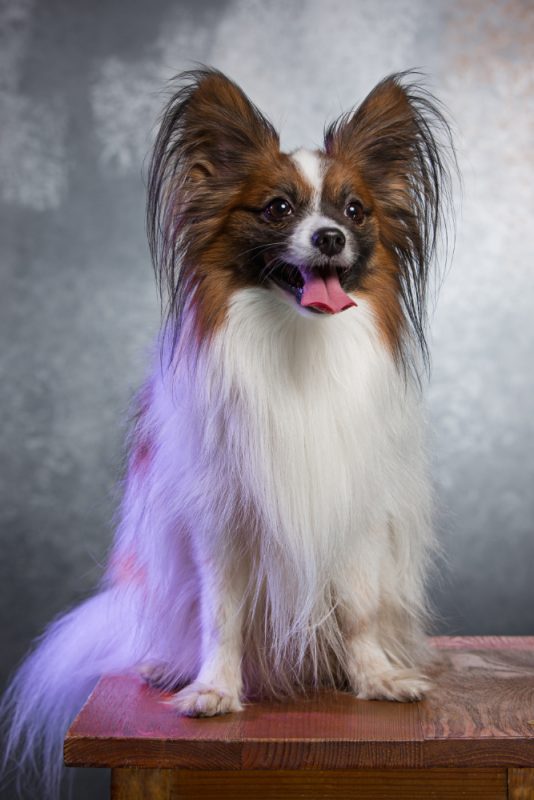
- Home
- Breed Info
- Papillon Breed Profile
Papillon Breed Profile

Overview
The Papillon is a small, intelligent, and highly affectionate toy breed, well-known for its distinctive butterfly-like ears. These energetic and agile dogs are popular companions due to their lively nature, intelligence, and adaptability. Despite their petite size, they have a bold and confident personality, making them an engaging and delightful pet for the right household.
History
The Papillon, whose name means “butterfly” in French, is one of the oldest toy breeds, dating back to at least the 16th century. Originally bred as companions for European nobility, they were frequently depicted in Renaissance paintings, often seen sitting beside their aristocratic owners. While historically known as the “Dwarf Spaniel,” their distinctive ears and elegant appearance led to the modern name, Papillon. There is also a variety known as the Phalène, which has drop ears instead of the signature upright ones.
Physical Characteristics
- Size: Small, typically weighing between 2.5 to 4.5 kg.
- Height: Ranges from 20 to 28 cm at the shoulder.
- Coat: Fine, silky, and long, with feathering on the ears, chest, and legs.
- Colours: Most commonly white with patches of black, red, or sable; symmetrical facial markings are highly desirable.
- Distinctive Features: Large, well-fringed ears resembling butterfly wings and a plumed tail carried over the back.
Temperament and Personality
Papillons are friendly, intelligent, and outgoing. They thrive on human companionship and are known for their affectionate and playful nature. Despite their small size, they have a bold and confident personality and often act like a much larger dog.
They are excellent watchdogs and will alert their owners to strangers, but they are not aggressive. Their intelligence and eagerness to please make them quick learners, and they excel in obedience training and dog sports such as agility.
Training and Exercise Needs
Papillons are highly trainable due to their intelligence and enthusiasm. They respond well to positive reinforcement methods, including treats and praise. Early socialisation is important to ensure they grow into well-mannered adults.
Despite their small size, they have moderate exercise needs and enjoy daily walks, play sessions, and mental stimulation through training or puzzle toys. They particularly excel in dog sports like agility, obedience, and even tricks training.
Living Conditions
Papillons are highly adaptable and can thrive in various living situations, including apartments, as long as they receive adequate attention and exercise. They do best in homes where they are not left alone for long periods, as they form strong bonds with their owners and may develop separation anxiety.
Due to their small size, they should be handled carefully, especially around young children. They generally get along well with other pets if introduced properly, though they may try to assert themselves around larger dogs.
Health and Lifespan
Papillons are generally a healthy breed with a lifespan of 12-16 years. However, they are prone to certain health issues, including:
- Patellar luxation: A common issue in small breeds where the kneecap can dislocate.
- Progressive Retinal Atrophy (PRA): A degenerative eye disorder that can lead to blindness.
- Dental issues: Small breeds often suffer from dental problems, so regular dental care is essential.
- Hypoglycemia: Puppies, in particular, may experience low blood sugar levels if not fed regularly.
Grooming
Papillons have a fine, silky coat that requires regular brushing to prevent tangles and matting. Fortunately, they do not have an undercoat, making grooming relatively easy. A weekly brush and occasional bath will keep their coat looking its best. Their ears, eyes, and teeth should also be checked and cleaned regularly.
Ideal Home
Papillons make excellent companions for a variety of owners, including singles, seniors, and families with older children. They are best suited for homes where they can receive plenty of attention and interaction. Due to their small size and delicate build, they are not ideal for rough play with young children.
They thrive in homes that provide mental stimulation and training, as they love learning and performing tricks. While they can adapt to apartment living, they do need regular exercise and playtime.
Popularity in Australia
Papillons are moderately popular in Australia, appreciated for their affectionate and intelligent nature. They are commonly seen in agility and obedience competitions, as well as in pet homes where they bring joy and companionship.
Adoption and Purchasing Considerations
Prospective owners should research responsible breeders who focus on health and temperament. Reputable breeders will perform health screenings and provide ongoing support. Adoption through breed-specific rescues and shelters is also an option for those looking to provide a home to a Papillon in need.
Conclusion
The Papillon is a charming and intelligent breed, well-suited to owners looking for an affectionate and energetic companion. Their intelligence and trainability make them a joy to own, but they do require regular mental and physical stimulation. With proper care, training, and socialisation, a Papillon can be a delightful and devoted pet for many years to come.
Disclaimer: The information provided is intended as a general guide. Prospective owners should speak with registered breeders and breed clubs to ensure the Papillon is a suitable match for their lifestyle. This guide is not a substitute for professional veterinary advice. Always consult your veterinarian for medical and health-related concerns regarding your pet.

Justin Jordan
Master Trainer
- In-home behaviour modification consultations
- Puppy schools
- Obedience classes
- Specialist training
- Media enquiries
- Trainer opportunities
- Supplier enquiries
- Guest appearances
















